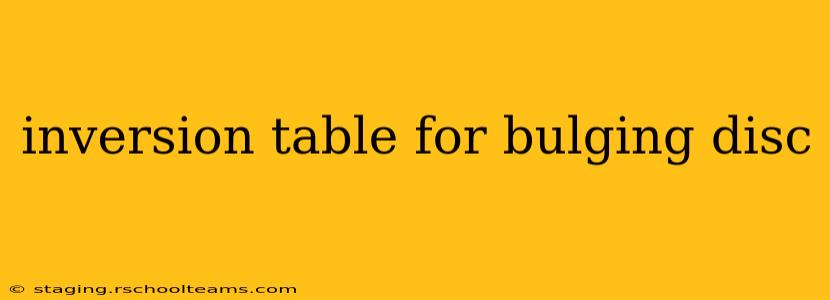A bulging disc, a common spinal condition, occurs when the soft, gel-like center of an intervertebral disc pushes against the outer layer, causing pain, discomfort, and sometimes nerve impingement. Many people explore alternative therapies to manage their symptoms, and inversion therapy, using an inversion table, is one such method. This article will delve into the potential benefits, risks, and considerations surrounding the use of an inversion table for a bulging disc.
What is an Inversion Table?
An inversion table is a device that allows you to safely invert your body, hanging upside down at varying angles. This inversion creates changes in spinal alignment and pressure distribution, which proponents suggest can alleviate back pain.
Can an Inversion Table Help with a Bulging Disc?
The purported benefits of inversion therapy for bulging discs stem from the reduction in spinal compression. When inverted, gravity pulls the body downwards, potentially creating space between the vertebrae and relieving pressure on the bulging disc. This decompression may reduce pain and inflammation. However, it's crucial to understand that inversion therapy is not a cure for a bulging disc. It's a supplemental therapy that may provide temporary pain relief for some individuals.
How Does Inversion Therapy Work for Bulging Discs?
The mechanism behind the potential benefits involves several factors:
- Decompression: The primary effect is the reduction of pressure on the spinal discs. This decompression may help to reduce the pressure on the bulging disc, easing pain.
- Improved Blood Circulation: Inversion can potentially increase blood flow to the spine, promoting healing and reducing inflammation.
- Muscle Relaxation: Hanging upside down can help to relax the back muscles, which may further contribute to pain relief.
- Stretching: Gentle stretching of the spine during inversion may help to improve spinal alignment and flexibility.
What are the Risks of Using an Inversion Table for a Bulging Disc?
While inversion therapy may offer benefits, it's essential to be aware of potential risks:
- Increased Pain: In some cases, inversion can actually worsen pain, especially if done incorrectly or if the condition is severe.
- Head Rush or Dizziness: Sudden inversion can cause dizziness or a head rush, especially in individuals with pre-existing conditions like hypertension or cardiovascular issues.
- Retinal Detachment: In rare cases, severe inversion can contribute to retinal detachment.
- Neck Injury: Improper use or excessive inversion can strain the neck.
- Muscle Strain: Overstretching can lead to muscle strains.
Who Should Avoid Using an Inversion Table?
Several groups of people should generally avoid using an inversion table:
- Individuals with severe spinal conditions: People with severe spinal stenosis, osteoporosis, spondylolisthesis, or recent spinal surgery should consult their doctor before using an inversion table.
- Pregnant women: Inversion is not recommended during pregnancy.
- Individuals with glaucoma or retinal detachment: The increased pressure in the head during inversion can worsen these conditions.
- Individuals with high blood pressure or cardiovascular disease: Inversion can temporarily increase blood pressure.
- Individuals with recent injuries: Allow sufficient time for healing before considering inversion therapy.
Is it Safe to Use an Inversion Table for a Bulging Disc?
The safety of inversion therapy for bulging discs depends on individual circumstances and proper usage. It’s crucial to consult a doctor or physical therapist before beginning inversion therapy. They can assess your specific condition and determine if inversion is appropriate and safe for you. They can also guide you on the proper technique and duration to minimize the risk of injury.
How Long Should I Use an Inversion Table?
The duration of inversion sessions should be gradually increased, starting with short periods (e.g., 1-2 minutes) and progressively increasing as tolerated. Never exceed the manufacturer's recommended time limits. Listening to your body and stopping if you experience any discomfort is crucial.
What are the Alternatives to Inversion Therapy for a Bulging Disc?
Many other effective treatments are available for managing bulging discs. These include:
- Physical therapy: A physical therapist can design a program of exercises and stretches to strengthen your back, improve flexibility, and reduce pain.
- Medication: Over-the-counter pain relievers (NSAIDs) or prescription medications may be used to reduce pain and inflammation.
- Epidural steroid injections: Injections can help to reduce inflammation around the nerves.
- Surgery: In rare cases, surgery may be necessary.
Remember, this information is for educational purposes only and does not constitute medical advice. Always consult with a healthcare professional before starting any new treatment, especially if you have a pre-existing medical condition. They can provide personalized recommendations based on your individual needs and health history.
